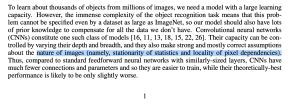This post was published in 2022-01-31. Obviously, expired content is less useful to users if it has already pasted its expiration date.
Table of Contents
python 类型注解
def func1(x:int) -> int:
return 'func1: not int'
if __name__ == '__main__':
print(func1('not int'))这段程序既不会引发报错也不会引发警告,会得到结果:
func1: not int更多内容见:🔗 [Python 3 新特性:类型注解 - 知乎] https://zhuanlan.zhihu.com/p/37239021
python: 看起来略微奇怪的else用法
for i in range(0,5):
print(i)
else:
print('else')输出结果:
0
1
2
3
4
else对程序进行一点修改:
errCode = 3
for i in range(0, 5):
if i == errCode:
break
else:
print(i)
else:
print('system normal')
得到:
0
1
2
更多解释,见:🔗 [if statement - Why does python use 'else' after for and while loops? - Stack Overflow] https://stackoverflow.com/questions/9979970/why-does-python-use-else-after-for-and-while-loops
AlexNet论文
论文:🔗 [ImageNet Classification with Deep Convolutional Neural Networks] https://proceedings.neurips.cc/paper/2012/file/c399862d3b9d6b76c8436e924a68c45b-Paper.pdf
中文讲解参考:🔗 [AlexNet 论文深度讲解 - 知乎] https://zhuanlan.zhihu.com/p/387848497
试图理解这个(被蓝色选中的文字):

未完成的内容
继续复习C语言
格式塔, Gestalt
Last Modified in 2022-02-26